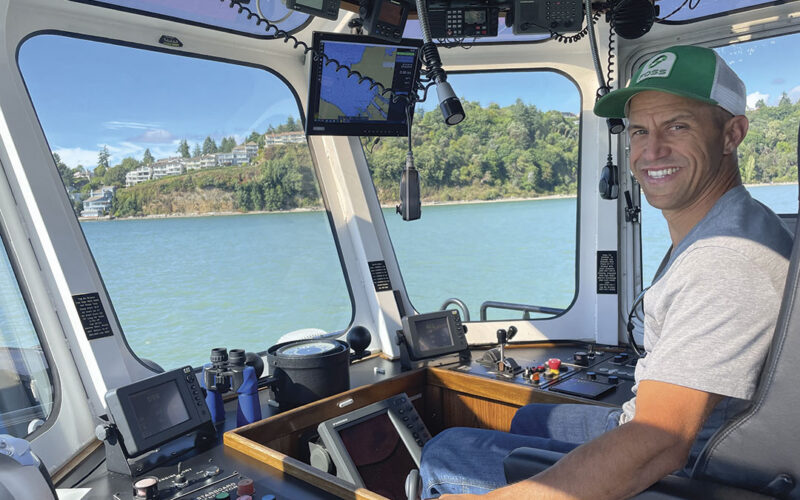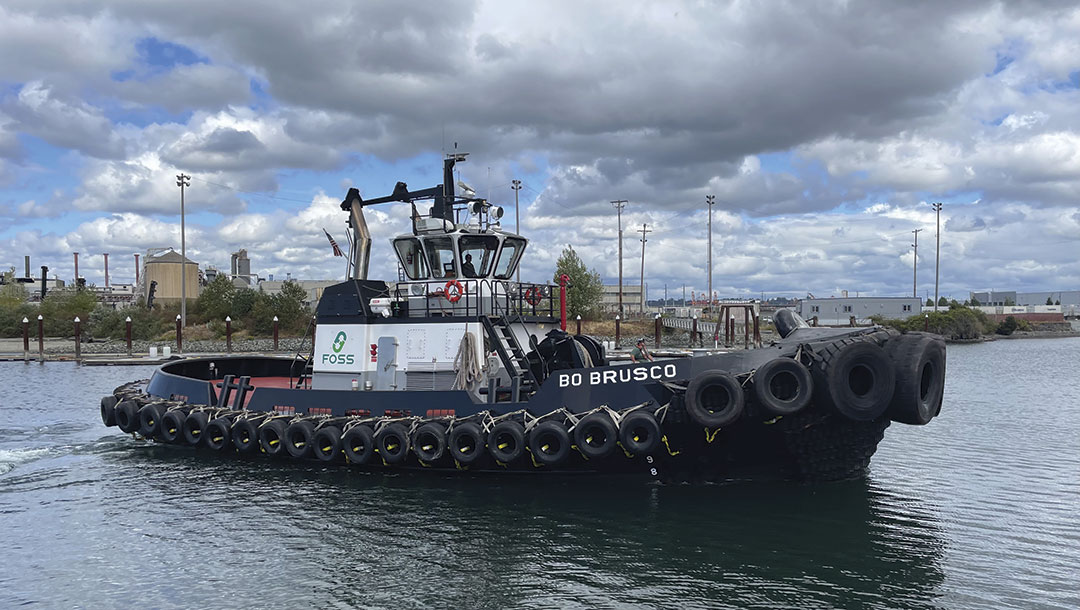
Capt. Darius Rogers steered Bo Brusco away from the Foss Maritime dock in Tacoma, Wa., and headed into Commencement Bay. Before long, TOTE’s cargo ship Midnight Sun rounded the peninsula at Browns Point.
The 839-foot roll-on, roll-off (RO-RO) Midnight Sun and its sister ship North Star are familiar sights in the Puget Sound. Both make weekly round trips between Tacoma and Anchorage, Alaska, carrying semi-trailers loaded with food, electronics, and other vital supplies.
Docking these ships is straightforward enough for the Foss captains who regularly work them. Even so, evolution has its challenges. Two tugboats will work in tandem to spin the ship 180 degrees then guide it into berth in the Blair Waterway, on the eastern edge of Commencement Bay.
“The TOTE ships call twice a week. It is a job we all have on lock down because we do it so often,” Rogers said aboard the 4,750-hp Bo Brusco. “Although they are a regular customer, I wouldn’t say it is routine.”
Carrying mostly empty trailers, Midnight Sun stood tall on the horizon framed by blue skies and the rugged Olympic Mountains. Winds were light out of the south and currents were minimal on the late-summer afternoon. In other words, conditions were nearly perfect.
The 4,700-hp Wedell Foss, operated by Capt. Katrina Anderson, loitered alongside Bo Brusco after dropping off a scrap metal barge. In time, the Puget Sound pilot conning Midnight Sun requested Bo work the bow. He placed Wedell aft as their respective crews got lines onto the hulking ship. Aboard Bo Brusco, that role fell to longtime engineer Bryan Morris.
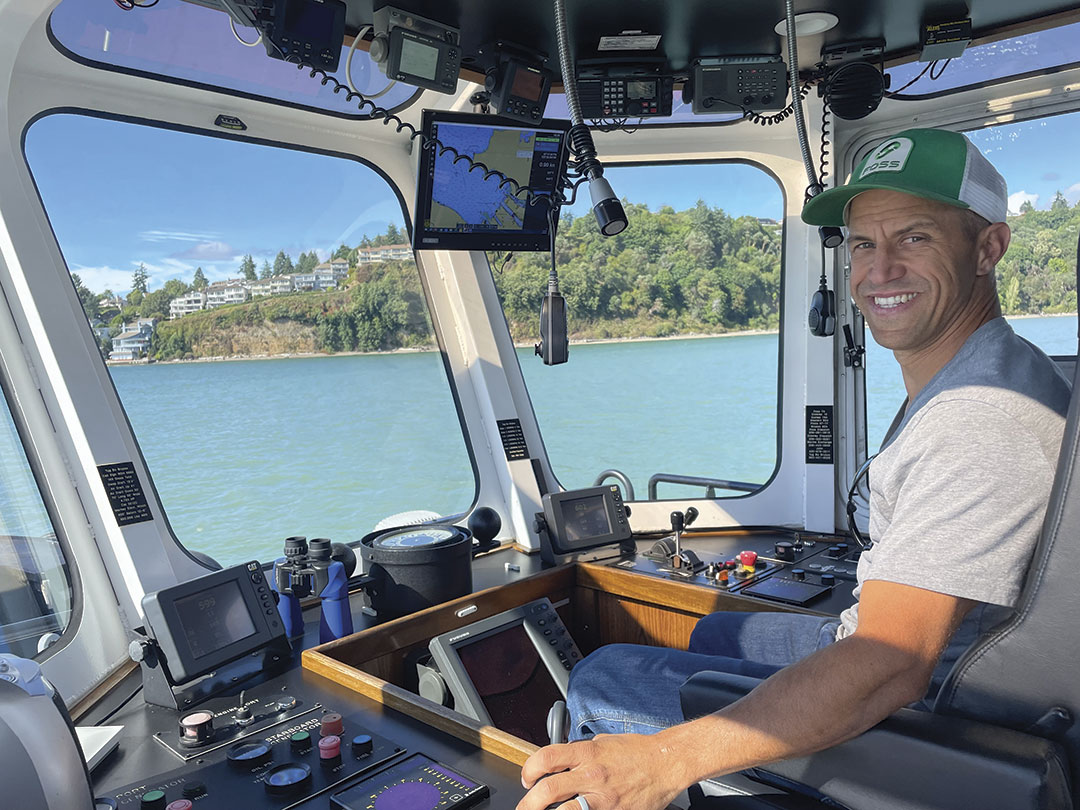
Rogers’ path into the helm chair aboard azimuthing stern drive (ASD) tugboats took some zigs and zags along the way.
A California native, in their younger days, he and his sister tried to best one another at docking their family’s runabout. After high school, Rogers spent two years mastering auto maintenance and working as a boat mechanic. He also taught English for 15 months at a school in a remote village in the Marshall Islands.
Rogers later worked days on deck for a charter fishing outfit in Sitka, Alaska, and made extra money repairing fishing boats at night. During charters, he took detailed notes on the locations where they caught fish, the weather conditions at the time, and the types of lures used.
One day, the charter captain asked what he was jotting down. “After hearing [what] I gathered, he told me I was too smart to be a fishermen and asked if I heard of the California Maritime Academy,” Rogers recalled. At that point, he hadn’t. “The captain told me about their program and how he wished he would have gone when he was younger. I applied as soon could get to a computer.”
After graduating from the Academy, Rogers worked on Crowley tugboats working in Western Alaska and the Yukon River and later moved to tankers. But he missed working on tugs and eventually Foss hired him as a second mate aboard an oceangoing tugboat, where he learned the basics of ASD propulsion.
By then, Rogers knew he wanted to work in the harbor. But he had no real connections at any of the big West Coast tug companies and no straightforward way to demonstrate his skills. Back in California, Rogers rigged a rowboat with two electric trolling motors modified to resemble ASD propulsion. He filmed himself performing complex maneuvers on the lake on his sister’s property.
He shared the videos, which are still available on YouTube, with prospective employers along with his resume. They apparently impressed the right people, who hired him at Foss’s San Francisco Bay division as a captain trainee and assistant port captain. Rogers worked on deck doing harbor towing work aboard conventional tugs before making his way up to captain a Foss ASD tugs five years ago.
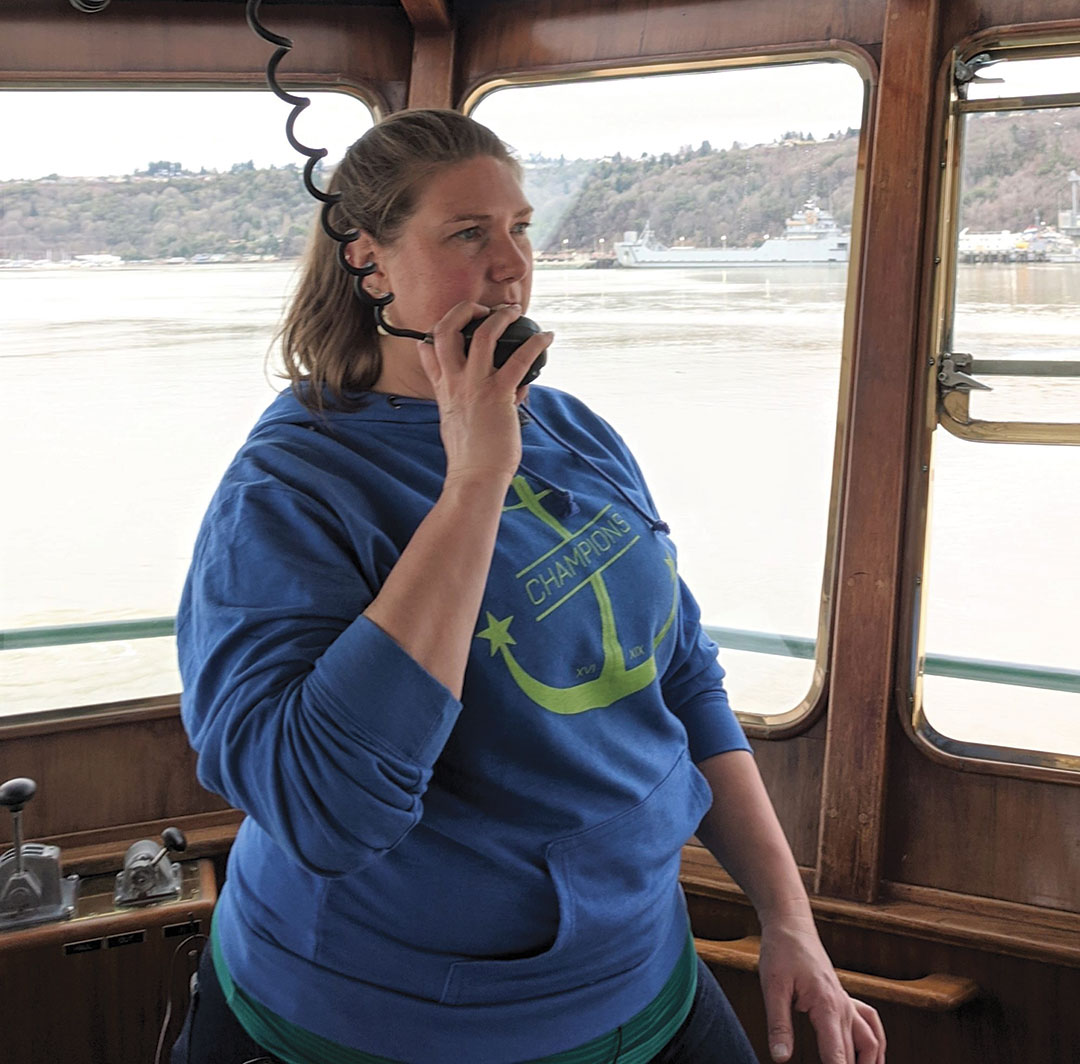
Anderson, the captain of the Wedell Foss, took a more familiar route into the trade. A fourth-generation tugboat captain, her family owned and operated Cook Inlet Tug & Barge in Anchorage until Foss’s parent company, Saltchuk, acquired it in 2011. She started working on tugs in high school and earned sea time during summer breaks from college in Washington.
“Every trip home, I worked on the tugboats to help pay for school,” she told an interviewer in 2020. “Once I graduated with a B.A. in Business Management, I returned to working for my dad and had enough sea time to test for my entry-level captain’s license.”
Anderson continued to build her license and in 2013 moved to the Puget Sound to operate tugboats for Foss.
Morris, meanwhile, joined Foss more than 30 years ago out of high school. He worked for many years on Wedell Foss and other Foss tugs before moving to Bo Brusco, which primarily operates as a day boat. “It is a lifestyle. It is all I have ever really done,” he said. “I like the work. It is interesting and it is always different, but always the same.”
Midnight Sun had slowed to about 3 knots when the pilot signaled it was time to turn the ship. Rogers, working center lead forward, paid out about 200 feet of line and positioned the tug about 90 degrees off the starboard bow. Bo Brusco backed at one-third and half power as the ship slowly came around with help from Wedell pulling off the port quarter.
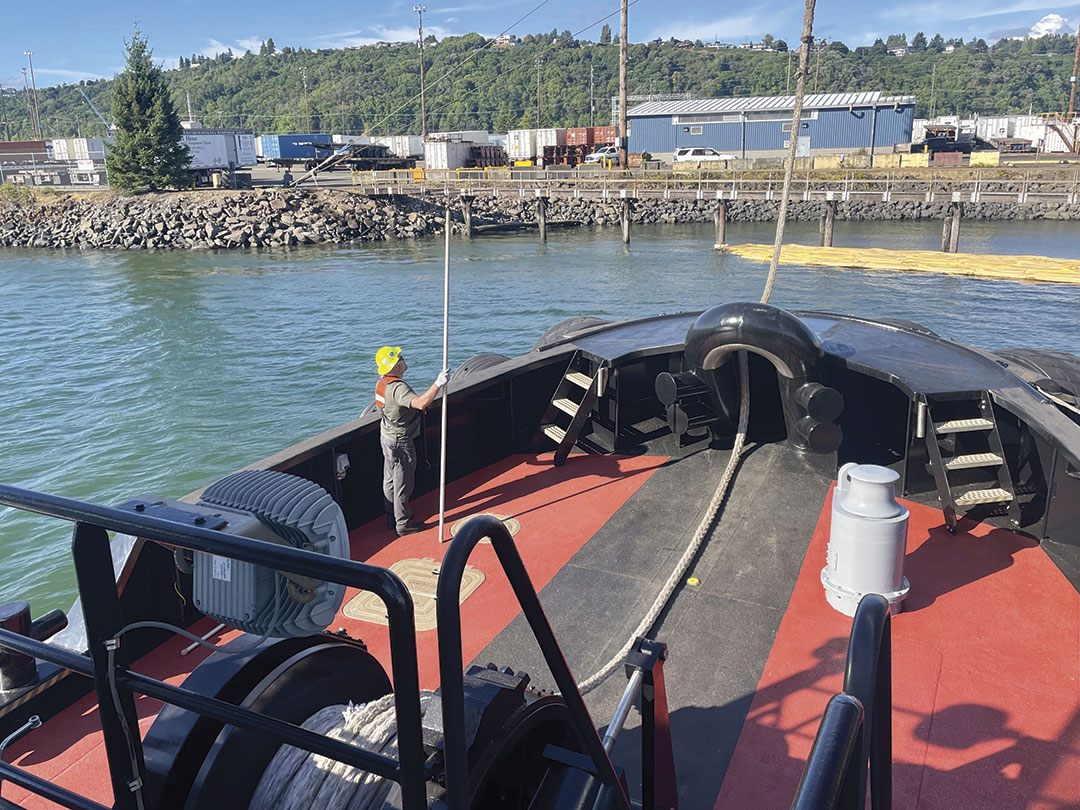
Within 10 minutes, the ship rotated 180 degrees clockwise to begin the second stage of its evolution. Midnight Sun backed under its own power along the centerline of the Blair Waterway with Wedell off the port quarter and Bo center lead forward, where it held the bow in position.
Tacoma is the historic home of Foss Maritime, one of the largest towing companies on the West Coast. Thea Foss and her husband Andrew founded the company in 1889 with a single used rowboat. Over time, it grew and diversified into passenger vessels, towing, shipbuilding, and other maritime businesses.
The Foss name now adorns a local high school, a Tacoma maritime museum and an inlet within Commencement Bay, among other local landmarks. Saltchuk, which also owns TOTE, bought the tug company in 1987.
The Port of Tacoma, meanwhile, consists of a handful of finger-like channels on either side of the Puyallup River. The river and its tributaries are fed by glaciers and snowmelt from Mt. Rainier some 60 miles away, giving the water a milky tan color that extends into Commencement Bay.
Heavy industry has long occupied a place in Tacoma, which recently embraced its reputation as “Grit City.” These days, the port is home to container yards, dry cargo terminals, an oil refinery and, until last summer, a paper mill that still occupies a prominent place on the city skyline.
“This is a busy port. Really busy at times,” Rogers said. “There is a lot of action and we get a good variety of ships. A lot of container ships, tankers, bulkers, heavy lift every now and then, and grain.
“It is a pretty fast-paced port,” he added, snapping his fingers for effect. “But I like it when all the work is stacked up. I like when we have five ships in a row and just knock ‘em all out.”
Foss, now based some 35 miles away in Seattle, operates more than a dozen tugs up and down the Puget Sound. This includes the 155-foot escort tugs Lindsey Foss and Garth Foss, the three 7,268-hp Arctic Class tugs and even a chartered boat or two, like Bo Brusco. Diversified Marine of Portland, Oregon, built it for Brusco Tug & Barge of Longview, Wash.
Powered by twin Tier 3 Caterpillar 3512C engines paired with Rolls-Royce z-drives, the 10-year-old Bo Brusco delivers 61.5 tons of bollard pull. Rogers describes the tug sporty, responsive and forgiving — with power that occasionally surprises the local pilots.
“The house is a little aft of midship, and it is low, so it can fit under the bow of any ship. There is never a time when we can’t work in the stem of a ship.”
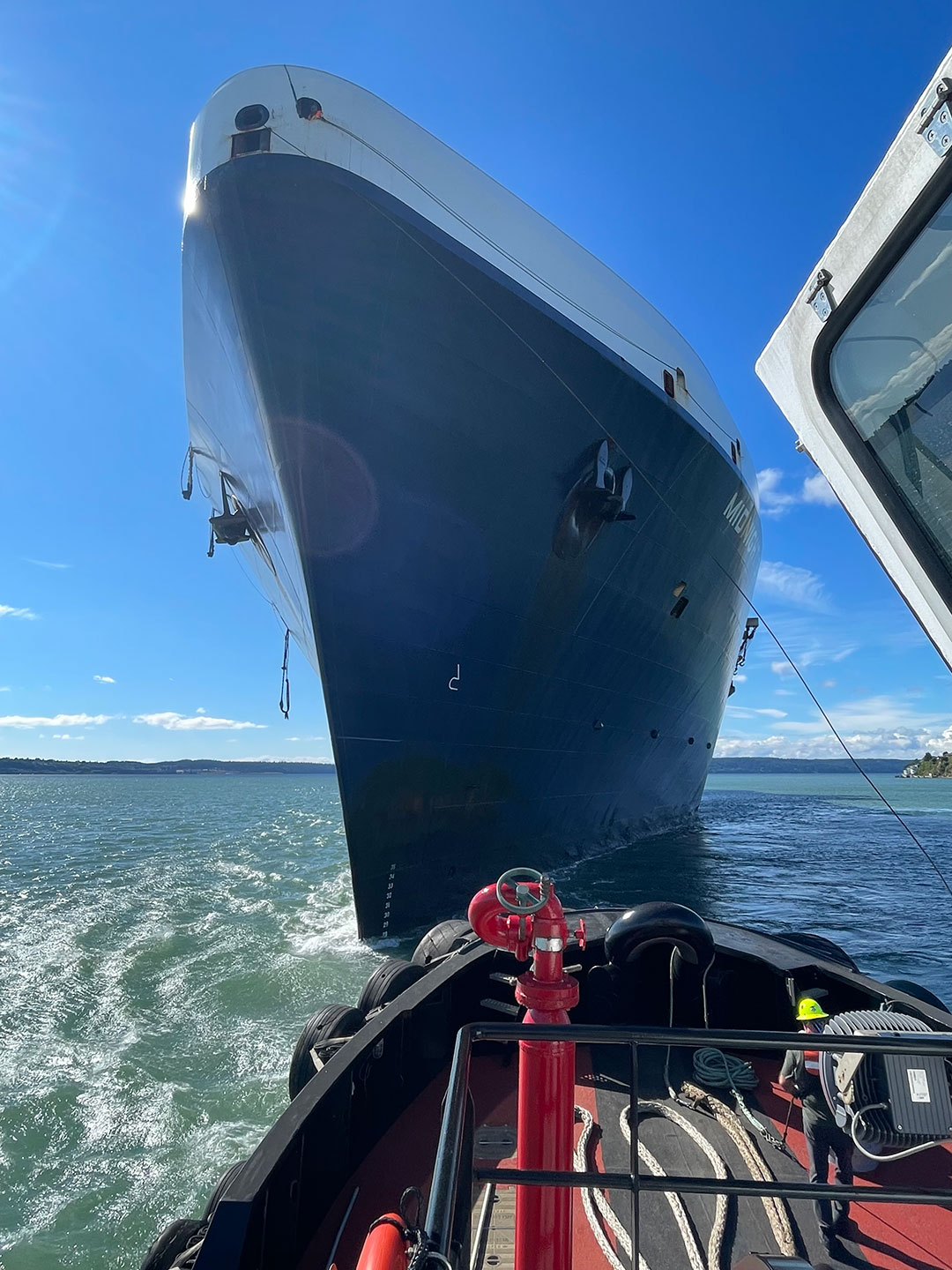
He demonstrated some of those traits just a few minutes later. With Midnight Sun approaching the TOTE berth in the Blair Waterway, the pilot requested Bo take position on the port bow. In a single, graceful maneuver, Rogers steered the tug in an arcing movement away from the port bow, spun nearly 90 degrees and went alongside the ship with its bow against the hull. He walked the tug to starboard at 1.5 knots while applying easy power against the hull.
Bo and Wedell nudged the ship a dozen or so times as the pilot guided the ship into berth. The tugs remained alongside while linesman secured it to the dock.
Midnight Sun wouldn’t be in Tacoma for long. The two Orca-class ships have 13 ramps across six decks, and each vessel can be unloaded and reloaded with fresh cargo in as little as eight hours. Quick turnarounds keep the ships in almost constant motion.
The massive ship was scheduled to sail early the following morning. But with other ships coming and going, there was plenty more for Rogers and Bo Brusco to do in the meantime. •

